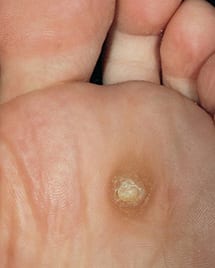Corn (Clavus)
Serving Hamilton, Stoney Creek, Grimsby and surrounding areas
Corns (Clavi):
- Are caused by:
- A bone in one toe, or sole of the foot, rubbing against the ground, the shoe, or another toe
- Repeated rubbing and pressure
- Pressure from improper footwear or changes in the shape of the feet, such as in diabetes
- When a bone rubs against a hard object, the overlying skin protects itself by getting thicker
- If the skin gets thick enough we refer to it as either a corn or a callus
- It is natural and normal to have calluses on the balls of the feet, under your heels and on the inside of your right middle finger where your pen or pencil rubs
- These are normal
- Soft corns are located in areas where moisture softens the skin, such as between the toes
- Corns on the soles, tops of the toes or other dry areas are called hard corns
- Corns hurt for several reasons:
- If they are infected, especially when they form an ulcer or break in the skin
- The underlying structures of the bone or joint can become inflamed
- The skin hurts because it is irritated
Treatment
- Pressure Reduction:
-
- Relieve the pressure causing the corn
- If the pressure is not relieved, then the corn will never get better
-
- Methods to reduce pressure are:
- Circular corn pads used to cushion the affected area
- Wearing comfortable shoes that fit well
- Orthotic insoles to help redistribute the pressure in the affected area
- Orthotic are usually prescribed by podiatrists and other foot specialists
- Orthotics are not made or fitted in my office
- Talk to your doctor about a referral to a qualified specialist for this service
- Methods to reduce pressure are:
- Salicylic acid preparations:
-
- Soften the corn and make it easier to remove with a pumice stone
- Liquid Nitrogen:
-
- It is a cold spray used to ‘freeze’ the corn to destroy it
- The treatments are painful and the area treated may remain painful for 1 to 2 days
- The treatment may produce a blister or a blood blister
- This is normal
- If the blister is painful, “pop” it with a sterile needle to let the fluid out
- The treated area requires no special treatment
- You may bathe normally
- A bandage is not necessary, although it may make the area more comfortable
- Treatment is usually done every 1 to 2 weeks
- If treatments are spread further apart, they are less effective
- Surgery:
-
- Surgery to trim the bone that is causing the abnormal pressure
- Surgery is performed by specialized surgeons for the feet
- Surgery on the bones of the feet is NOT offered in my office, please talk to your doctor about a referral to a foot surgeon
What if you are interested to learn more?
If you would like to learn more please phone the aesthetic centre directly at (905) 549-7873 to book a free consultation with one of our knowledgeable technicians or

